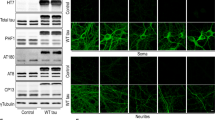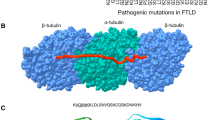Abstract
1. Transformed (TR) cell lines showed faster doubling times and higher cell densities at confluence, as well as altered morphology, changing from flat epitheloid to smaller round or bipolar shapes. Since such morphological changes are suggestive of alterations in intermediate filaments, we have analyzed the expression of both vimentin and neurofilament.
2. Immunohistochemical analysis of vimentin showed a redistribution from a cytoplasmic network to a perinuclear accumulation in TR cell lines.
3. Western blot analysis demonstrated that the vimentin content was decreased 60–90%. The content of the 70-kD neurofilament protein was also decreased in TR cells, but its intracellular distribution was indistinguishable from that in the control cell lines.
Similar content being viewed by others
REFERENCES
Benes, F. M., Majocha, R., Bird, E. D., and Marotta, C. A. (1987). Increased vertical axon numbers on cingulate cortex of schizophrenics. Arch. Gen. Psych. 44:1017–1021.
Ben-Ze'ev, A. (1984). Inhibition of vimentin synthesis and disruption of intermediate filaments in simian virus 40-infected monkey kidney cells. Mol. Cell. Biol. 4:1880–1889.
Ben-Ze'ev, A., Zöller, M., and Raz, A. (1986). Differential expression of intermediate filament proteins in metastatic and nonmetastatic variants of the BSp73 tumor. Cancer Res. 46:785–790.
Biedler, J. L., Helson, L., and Spengler, B. A. (1973). Morphology and growth, tumorigenicity, and cytogenetics of human neuroblastoma cells in continuous culture. Cancer Res. 33:2643–2652.
Bradford, M. M. (1976). A rapid and sensitive method for the quantitation of microgram quantities of protein utilizing the principle of protein dye binding. Anal. Biochem. 72:248–254.
Carden, M. J., Schlaepfer, W. W., and Lee, V. M-Y. (1985). The structure, biochemical properties, and immunogenicity of neurofilament peripheral regions are determined by phosphorylation state. J. Biol. Chem. 260:9805–9817.
Ciesielski-Treska, J., Ulrich, G., and Aunis, D. (1991). Protein kinase C-induced redistribution of the cytoskeleton and phosphorylation of vimentin in cultured brain macrophages. J. Neurosci. Res. 29:362–378.
Cochard, P., and Paulin, D. (1984). Initial expression of neurofilaments and vimentin in the central and peripheral nervous system of the mouse embryo in vivo. J. Neurosci. 4:2080–2094.
Franke, W. W., Schmid, E., Winter, S., Osborn, M., and Weber, K. (1979). Widespread occurrence of intermediate-sized filaments of the vimentin type in cultured cells from diverse vertebrates. Exp. Cell. Res. 123:23–46.
Hornby, A. E., Pan, J., and Auersperg, N. (1992). Intermediate filaments in rat ovarian surface epithelial cells: Changes with neoplastic progression in culture. Biochem. Cell Biol. 70:16–25.
Karson, C. N., Garcia-Rill, E., Biedermann, J., Mrak, R. E., Husain, M. M., and Skinner, R. D. (1991). The brain stem reticular formation in schizophrenia. Psych. Res. Neuroimaging 40:31–48.
Lee, V. M.-Y., Carden, M. J., Schlaepfer, W. W., and Trojanowski, J. Q. (1986). Structural similarities and differences between neurofilament proteins from five different species as revealed by monoclonal antibodies. J. Neurosci. 6:2179–2186.
Lee, W.-C., Yu, J.-S., Yang, S.-D., and Lai, Y.-K. (1992). Reversible hyperphosphorylation and reorganization of vimentin intermediate filaments by okadaic acid in 9L rat brain tumor cells. J. Cell. Biochem. 49:378–393.
Lilienbaum, A., Legagneux, V., Portier, M.-M., Dellagi, K., and Paulin, D. (1986). Vimentin gene: Expression in human lymphocytes and in Burkitt's lymphoma cells. EMBO J. 5:2809–2814.
Lipsky, R. H., and Silverman, S. J. (1987). Effects of mycophenolic acid on detection of glial filaments in human and rat astrocytoma cultures. Cancer Res. 47:4900–4904.
Mahadik, S. P., Mukherjee, S., Laev, H., Reddy, R., and Schnur, D. B. (1991). Abnormal growth of skin fibroblasts from schizophrenic patients. Psych. Res. 37:309–320.
Murray, R. M., O'Callaghan, E., Castle, D. J., and Lewis, S. W. (1992). A neurodevelopmental approach to the classification of schizophrenia. Schiz. Bull. 18:319–332.
Nixon, R., and Shea, T. B. (1992). Dynamics of neuronal intermediate filaments: A developmental perspective. Cell Motil. Cytoskeleton 22:81–91.
Ochs, D. C., McConkey, E. H., and Guard, N. L. (1981). Vimentin-derived proteins. Differences between human fibroblasts and transformed human cells. Exp. Cell Res. 135:355–362.
Oleszak, E. L., Manuelidis, L., and Mannuelidis, E. E. (1986). In vitro transformation elicited by Creutzfeldt-Jakob-infected brain material. J. Neuropathol. Exp. Neurol. 45:498–502.
Poltorak, M., Stevens, J. R., Freed, W. J., and Casanova, M. F. (1988). The expression of phosphorylated neurofilament epitopes in human brains. Brain Res. 475:328–332.
Schlaepfer, W. W. (1987). Neurofilaments: Structure, metabolism and implications in disease. J. Neuropathol. Exp. Neurol. 46:117–129.
Shea, T. B. (1990). Transient increase in vimentin in axonal cytoskeletons during differentiation in NB2a/d1 cells. Brain Res. 521:338–342.
Shirabe, S., Stevens, J. R., and Schwartz, J. P. (1993). Characterization of a transmissible growth-promoting agent derived from CSF of schizophrenic patients which is active on human neuroblastoma cells. J. Neurosci. Res. 34:622–628.
Takeda, M., Nishimura, T., Hariguchi, S., Tatebayashi, Y., Tanaka, T., Tanimukai, S., and Tada, K. (1991). Study of cytoskeletal proteins in fibroblasts cultured from familial Alzheimer's disease. Acta Neurol. Scand. 84:416–420.
Trojanowski, J. Q. (1987). Neurofilament proteins and human nervous system tumors. J. Histochem. Cytochem. 35:999–1003.
Tyrrell, D. A. J., Crow, T. J., Parry, R. P., Johnstone, E. C., and Ferrier, I. N. (1979). Possible virus in schizophrenia and some neurological disorders. Lancet 1:839.
Tyrrell, D. A. J., Perry, R., Davies, H., Bloxham, C., and Crow, T. J. (1983). Further studies of the cytopathic effect in tissue cultures inoculate with CSF from patients with schizophrenia and other nervous system diseases. J. Exp. Pathol. 64:445–450.
Author information
Authors and Affiliations
Rights and permissions
About this article
Cite this article
Shirabe, S., Fang, W.H. & Schwartz, J.P. Altered Intermediate Filament Expression in Human Neuroblastoma Cells Transformed by a Growth-Promoting Agent Derived from Schizophrenic CSF. Cell Mol Neurobiol 17, 1–11 (1997). https://doi.org/10.1023/A:1026320919282
Issue Date:
DOI: https://doi.org/10.1023/A:1026320919282




